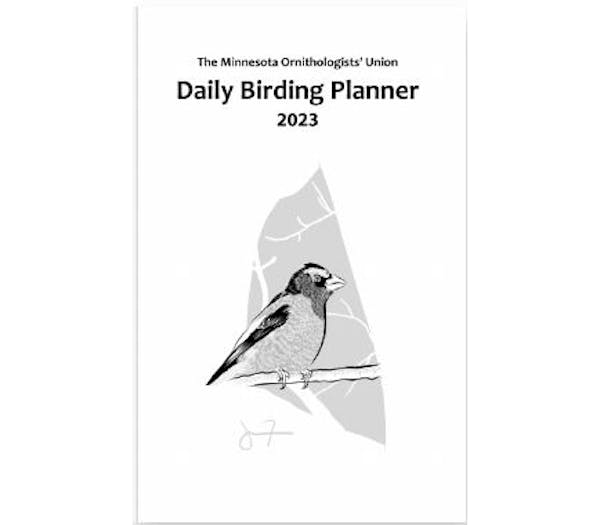The publication of a small 114-page book in 1974 changed Minnesota birding forever.
The book was "A Birder's Guide to Minnesota," the first of five editions by the state's premier bird guide, Kim Eckert of Duluth.
The fifth edition should be in stores next month. It will be every bit as exciting for birders today as was the first 48 years ago.
That early guide detailed 150 places to find birds here. The total grew with each edition, reaching over 1,400 well-vetted birding sites in the new book.
Minnesota is an excellent state for birding. A survey some time ago by the American Birding Association asked members to list their most-sought after North American bird species. In a compiled list of the top 50 species, 18 are found here.
Of the top 11 most-wanted North American species we have seven.
Diversity of habitat here is the reason, Eckert explains in the introduction to his book. Our wooded counties, southeast and central, remnants of the historic Big Woods, adjoin prairie to the west and boreal forest to the north.
The book explores all three biomes in extensive detail.
Eckert came to Duluth in 1977 after a brief teaching career in South Dakota. He is a graduate of St. John's University in Collegeville, Minn. He began actively birding in Minnesota while a student there.
In Duluth he served for 20 years as naturalist at Hawk Ridge Nature Reserve. In 1986 he began his own bird tour business after serving 30 years with Victor Emanuel Nature Tours, leading birding trips throughout North America.
His tours, Minnesota Birding Weekends, have taken birders to every corner of the state in every season. These were and are the lowest-priced and most popular birding tours you can find ($20 to $70 depending on trip length and duration not counting motels and meals). Participants caravan in cars.
After a COVID hiatus, the trips resume for 2022-2023 (mbwbirds.com/mbweekends.html). This will be the 37th season.
The extensive notes Eckert has taken on more than 440 such trips are the basis for his books. More than 80 trip participants also have contributed.
The book is illustrated with over 180 color photos. It contains dozens of detailed maps to site locations. The book contains many QR codes that lead you to maps on the internet.
There is an annotated list of the 447 bird species recorded in the state by publication time. Eckert has seen more than 400 of them.
(That list has grown by one since then. A phainopepla, a bird of southern Arizona and California, was found along the North Shore near Duluth on Oct. 29. Eckert was among many birders who saw it.)
Robert Janssen, our senior birder, author of three Minnesota birding books himself, told me that Eckert's books have had more influence on birding here than any other book in any other state.
"It's an important book, a master guide for finding birds in Minnesota.," he said. "It's down to Earth, helping basic birders know our birds."
The book, published by Stone Ridge Press, will be widely available sometime in December. The book is soft-covered and spiral-bound. Price is $34.95.
Previous editions, long out of print, have reached the price of collectibles.
Lifelong birder Jim Williams can be reached at woodduck38@gmail.com.
Minnesota's top 18 birds
The 18 species of birds found here that made the ABA top-50 list are yellow rail, boreal owl, great gray owl, gyrfalcon, hawk-owl, snowy owl, Northern three-toed woodpeckers, black-backed three-toed woodpecker, spruce grouse, Connecticut warbler, harlequin duck, Bohemian waxwing, Baird's sparrow, Henslow's sparrow, goshawk, Sprague's pipit, hoary redpoll and Smith's longspur.
Excerpt from "A Birder's Guide to Minnesota"
"Over 400 miles separate the Minnesota-Iowa border from the Northwest Angle peninsula up on Lake of the Woods, the northernmost point in the 48 contiguous United States. The four corners of the state are even more remote from each other. Standing among the aspen groves and magpies in northwestern Kittson County, you would be nearer to the Canadian outposts of Saskatoon and Flin Flon than the southeastern corner of Houston County. In turn, a prothonotary warbler singing in Houston County's Mississippi backwaters lies closer to Louisville and Cincinnati than to Kittson County. Similarly, a blue grosbeak nest in the southwestern corner of Rock County is closer to Cheyenne, Wyoming, than to Grand Portage up in Cook County, while Grand Portage is as close to the James Bay portion of Hudson Bay as it is to Rock County."
Singing, ceremonies and straw hats: Olympics opening ceremony in Tahiti centers Polynesian culture

Three 101-year-old friends recall fond memories in 1940s Alexandria
Celine Dion makes musical comeback at Paris Olympics with Eiffel Tower serenade




